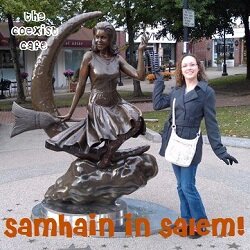We take a break from your regular Samhain in Salem programming to bring you a really interesting article I read this morning.
I blame this interruption on Matt. In one fell swoop, he managed to weird me out about the honey on your average supermarket shelf and suck me into something known as CNN’s Eatocracy. He knows how obsessed I am with food, especially food that comes from weird places or with weird stories. Why did he do this!
Hours later and several articles under my belt, I came across one about the McRib, and was suddenly reminded of my post not too long about meat glue when the article said:
“Restructured meat products are commonly manufactured by using lower-valued meat trimmings reduced in size by comminution (flaking, chunking, grinding, chopping or slicing). The comminuted meat mixture is mixed with salt and water to extract salt-soluble proteins. These extracted proteins are critical to produce a ‘glue’ which binds muscle pieces together. These muscle pieces may then be reformed to produce a ‘meat log’ of specific form or shape.” Mandigo told the authors of a University of Nebraska report on restructured meat products.
[...]
“That material,” as Mandigo calls it, is pork trimmings – but not from the rib. According to McDonald’s Executive Chef Dan Coudreaut, it’s primarily shoulder and loin meat, chopped and formed into a boneless patty in the shape of a four-ridged rib slab, and then quickly frozen until it meets it final fate on a restaurant grill. Then it’s slathered in sauce, topped with pickles and raw onion and served in a long, soft white bun. That’s in adherence to the original recipe formulated by McDonald’s first Executive Chef Rene Arend – also credited with the invention of the Chicken McNugget.
Oh god… I’m gagging just thinking about it.
I know many veg*ns will say that the process is a lot like that used to make Morningstar Riblets (which are amazingly delicious but may, according to one blogger, induce McRib-related nightmares [weirdo]), but those riblets are made of textured vegetable protein and other non-sinewy and non-meat-log materials.
Seriously, guys. Meat logs. Made from muscle pieces with meat glue. Shaped like a rib and slathered in what I’m sure is mostly-HFCS barbecue sauce. What the ever-loving…
The McRib comes and goes, leaving its mark in the form of barbecue stains on cheeks and t-shirts and leaving many McDonald’s enthusiasts craving even more. But why does it keep reincarnating like some kind of masochistic Jesus figure?
I actually think it’s some kind of marketing ploy, and if so, it’s brilliant. More than that, though, is the fact that those trimmings — you know, the ones held together by salt-soluble proteins from comminuted meat trimmings? — can actually go for a lot when they’re being used often. Especially since pork trimmings, the main component used in a McRib (I think…), are typically more limited in supply than beef trimmings.
Which is why the McRib is such a “here today, gone tomorrow” product: Wouldn’t want it to get too expensive! Roger Mandigo, a recent inductee into the Meat Industry Hall of Fame and innovator in restructured meat products (I didn’t even know there was such a thing), said, “If you suddenly start to buy a large amount of that material[*], the price starts to rise.”
* LOL… “material”. It’s not even food.
Well. Duh. So it’s safe to say that, like every other time, the McRib is here only for a short time, and will likely never be a permanent thing. If you’re into it, I say, go for it… but at least know what you’re eating. Or at least, as much as you can…













 Stephanie Fox
Stephanie Fox







I never wanted one of those things, and boy am I glad now!
Seriously! I knew they were strange, but I never thought they were THIS strange!
Makes you wonder what’s in their burgers… o_O
*Nods in agreement*